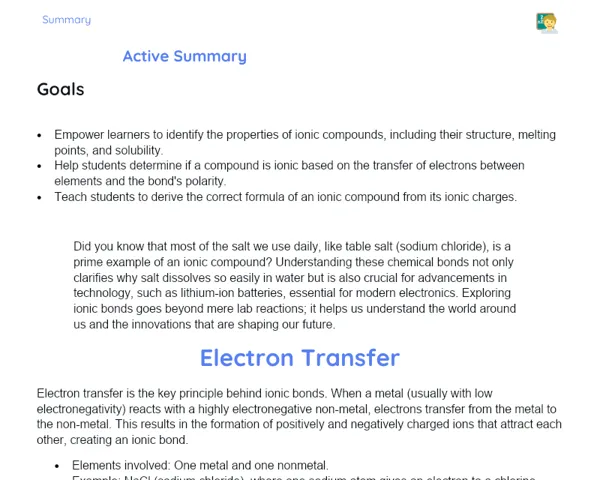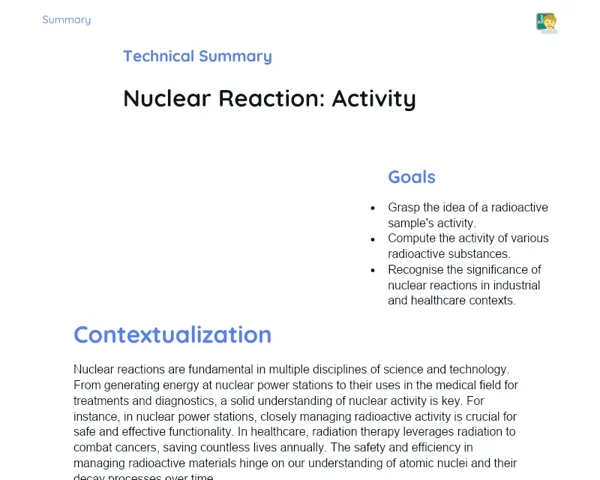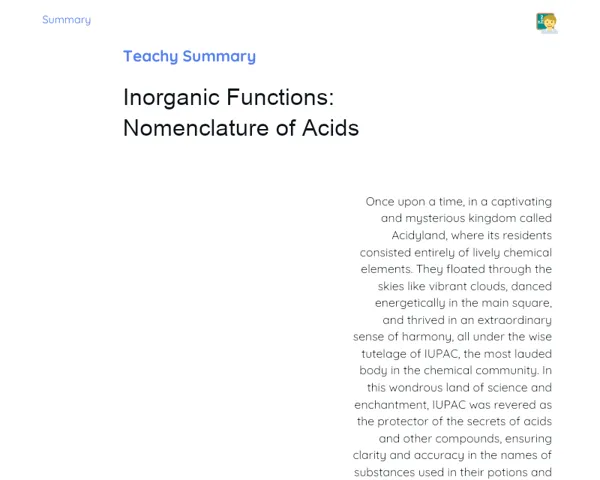Socioemotional Summary Conclusion
Goals
1. Identify the molecular geometry of various molecules, such as the bent shape of the water molecule.
2. Understand the physical and chemical properties resulting from molecular geometry.
Contextualization
Did you know that the way atoms are arranged in a molecule can determine if it's solid or liquid at room temperature? Take water for instance – it has a bent molecular structure, giving it special properties like the ability to dissolve many substances and support life on Earth. Let's delve into how minor changes in the 'dance' of atoms can have significant effects on our environment!
Exercising Your Knowledge
Molecular Geometry
Molecular Geometry deals with the three-dimensional arrangement of atoms in a molecule. This layout dictates many of the physical and chemical characteristics of the substance. For example, the bent shape of the water molecule enables it to have unique surface tension and solubility traits. Understanding molecular geometry is akin to grasping a dance routine, where each step or position of the dancers (atoms) choreographs the final performance.
-
Three-Dimensional Arrangement: Molecular geometry involves the position of atoms in three-dimensional space, crucial for understanding molecular interactions.
-
Influenced Properties: The shape of a molecule dictates its properties, including melting and boiling points, solubility, and chemical reactivity.
-
Visual Analogies: Comparing molecular geometry to dance or architecture can help learners engage with this concept more deeply.
Valence Shell Electron Repulsion Theory (VSEPR)
VSEPR Theory is a model that predicts molecular shapes based on the repulsion between electron pairs. According to this theory, electron pairs around a central atom repel each other, arranging themselves to keep as far apart as possible.
-
Principle of Repulsion: Electron pairs push away from each other, positioning themselves at a maximum distance to lessen repulsion.
-
Geometry Prediction: By utilizing VSEPR Theory, we can foresee the molecular geometry of various substances, essential for lightening our understanding of their reactivity and physical traits.
-
Practical Applications: Comprehending this theory aids in demystifying chemical reactions and crafting new materials and medicines.
Molecular Geometry Models
Molecular geometry models like linear, bent, trigonal planar, tetrahedral, etc., illustrate the shape of molecules. These models not only enhance theoretical understanding but are also foundational for practical chemical applications.
-
Standard Models: Linear, Bent, Trigonal Planar, Tetrahedral, among others, are common molecular geometry models.
-
Practical Examples: Molecules such as CO₂ (linear), H₂O (bent), and CH₄ (tetrahedral) exemplify these models.
-
Visual Importance: Using physical or virtual models to portray molecular geometry can aid students in better grasping the concept and applying the knowledge effectively.
Key Terms
-
Molecular Geometry: Three-dimensional arrangement of atoms in a molecule.
-
VSEPR Theory: A model that leverages the repulsion of electron pairs to forecast molecular geometries.
-
Linear: A molecular arrangement where the atoms line up straight.
-
Bent: A molecular shape where atoms create an angle with each other.
-
Tetrahedral: Geometry arranging atoms in a tetrahedral form around the central atom.
For Reflection
-
How can grasping molecular geometry enrich our understanding of our own emotions and thoughts?
-
How did collaborating during the construction of molecular models enhance your socio-emotional skills, like empathy and teamwork?
-
What methods did you use or could use to manage emotions like frustration or joy while engaging in this activity? How might these strategies benefit other areas of your life?
Important Conclusions
-
Molecular Geometry illustrates the three-dimensional arrangement of atoms in a molecule, impacting its physical and chemical attributes.
-
VSEPR Theory enables us to predict molecular shapes based on the repulsion of valence electron pairs.
-
Understanding models of molecular geometry, such as linear, bent, and tetrahedral, is crucial for comprehending the reactivity and properties of molecules.
-
Grasping molecular geometry is vital not just for chemistry, but also for nurturing socio-emotional skills like teamwork and emotional regulation.
Impacts on Society
Molecular Geometry plays a vital role in our day-to-day lives. For instance, the bent shape of water is what gives it remarkable dissolving capabilities, essential for sustaining life on Earth. Everyday products we rely on, such as medications, are formulated based on this knowledge, improving our quality of life. Moreover, understanding molecular geometry enables us to predict and monitor chemical reactions, which is crucial in various sectors, from food production to technology. In this context, the ability to comprehend and apply molecular geometry sparks innovation and scientific advancement. For students, this not only expands their career opportunities but also enhances their capacity to work collaboratively and manage their emotions effectively. Recognising and regulating feelings during scientific study is a skill applicable in all aspects of life, contributing to ongoing emotional well-being.
Dealing with Emotions
To assist in managing your emotions while studying Molecular Geometry and its applications, I'd like to suggest an exercise based on the RULER method. When you face a challenge, take a moment to pause and acknowledge the emotions you're experiencing, whether it’s frustration, curiosity, or excitement. Next, work to understand what triggered these feelings. For instance, if you're feeling frustrated about not being able to build a model, give it a name. Express these emotions in a healthy way, like chatting with a friend or journaling. Finally, practice regulating these feelings—consider taking a break, breathing deeply, or reaching out for help. This exercise can help you maintain focus and tranquillity, not only in your studies but also in any challenging situations.
Study Tips
-
Review molecular geometry content with hands-on models or online 3D visualisation tools to make your studying more interactive and engaging.
-
Form study groups with your classmates to discuss and build molecular models together. Exchanging knowledge and collaborating will enhance your understanding.
-
Use analogies and comparisons, such as the 'dance of the atoms,' to simplify complex abstract concepts. This can aid in memorising and comprehending the topic.



